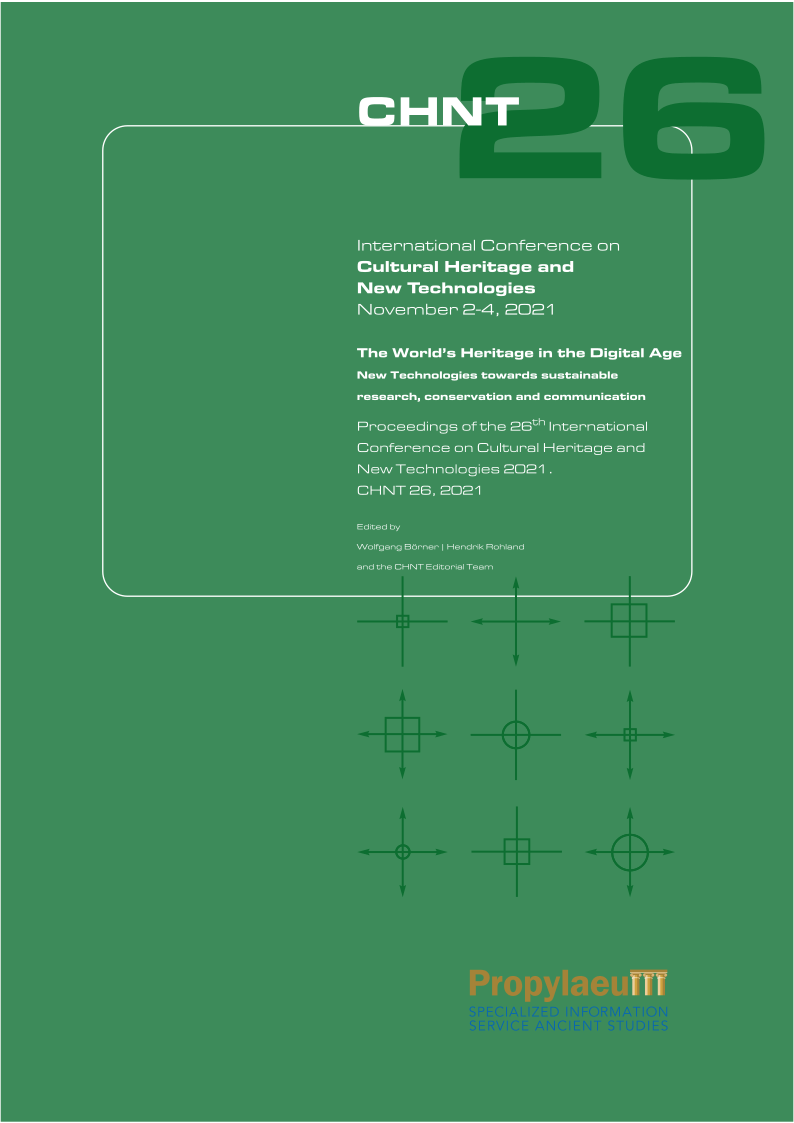The Visualisation of Construction Principles of Antique Architecture
An Antic Amphitheatre Visually Explored
Keywords:
Visualisation, Hypotheses, Uncertainty, Architecture, PrinciplesAbstract
At the last CHNT conference we illustrated our method of visualisation of hypotheses as a counterposition of presumed virtual reconstructions of architecture. A visualisation of a hypothesis is profoundly different from a virtual reconstruction. The difference lies in the understanding of what is to be shown in the face of what can be expressed scientifically. Reconstruction claims that it is possible to rebuild a lost building. That may be possible in some cases. In the case of ancient buildings such as this amphitheatre, where the findings are less than sparse, this is quite impossible. This is why we developed our method of visualisation of hypotheses. It emphasises that archaeological knowledge consists of a wide range of uncertainty including contradictions rising from multiple equally valid scientific assumptions. Instead of pure diagrams, we work with subtle indications, mainly through versatile geometric abstraction. Contrary to the literal meaning this does not mean leaving things away but designing new and evident shapes of representation. Abstract shapes are then compensated by virtual architectural photography.
References
J.-C. Golvin, L'Amphithéâtre romain: Essai sur la théorisation de sa forme et de ses fonctions, 2 vols (Publications du Centre Pierre Paris XVIII). Paris: de Boccard, 1988
É. Follain, La restitution du centre monumental romain d’Apollonia d’Illyrie: l’exemple du monument des agono-thètes. Virtual Retrospect 2009, Robert Vergnieux, Nov 2009, Pessac, France
R. Graefe, Vela Erunt: Die Zeltdächer der römischen Theater und ähnlicher Anlagen, 1979, von Zabern, Mainz
Deuring, D. (2016) ‘Digitale Modellierung antiker Bauten. Wie archäologische Hypothesen in Visualisierungen über-setzt werden’, in Graßhoff, G. and Meyer, M. (ed.) Raumwissen, volume 17. Berlin: Excellenzcluster Topoi, pp. 38–43.
Lengyel, D. and Toulouse, C. (2013) ’Die Bauphasen des Kölner Domes und seiner Vorgängerbauten: Gestaltung zwischen Architektur und Diagrammatik‘, in Boschung, D. and Jachman, J. (ed.) Diagrammatik der Architektur. Tagungsband Internationales Kolleg Morphomata der Universität zu Köln. Paderborn: Wilhelm Fink. pp. 327–352.
Lengyel, D. and Toulouse, C. (2016) ‘Die digitale Visualisierung von Architektur‘, in Deutscher Verband für Archäo-logie (ed.) Blickpunkt Archäologie, volume 2/2016. München, Stuttgart, Darmstadt: Pfeil; Theiss; Wissenschaft-liche Buchgesellschaft. pp. 91–98.
Lengyel, D. and Toulouse, C. (2017) ’Die Echtersche Idealkirche. Eine interaktive Annäherung’, in Dombrowski, D., Maier, M. J. and Müller, F. (ed.) Julius Echter. Patron der Künste: Konturen eines Fürsten und Bischofs der Re-naissance. Berlin: Deutscher Kunstverlag. pp. 127–129.
Lengyel, D. and Toulouse, C. (2019) ’Zum Erscheinungsbild der Visualisierungen des Berner Münsters’, in Nicolai, B., Schweizer, J. (ed.) Das Berner Münster. Das erste Jahrhundert: Von der Grundsteinlegung bis zur Chorvoll-endung und Reformation (1421–1517/1528). Regensburg: Verlag Schnell & Steiner GmbH, pp. 218–230.
Lengyel, D. and Schaerer, P. (2020) ‘Visualisation’, in Hovestadt, L., Hirschberg, U. and Fritz, O. (ed.) Atlas of Dig-ital Architecture: Terminology, Concepts, Methods, Tools, Examples, Phenomena. Basel: Birkhäuser, 2000, pp. 284–323.
Märtin, R.-P. and Wulf-Rheidt, U. (2012) ‘Räume verwandeln. Der Palatin in Rom’, in Excellence Cluster Topoi (ed.) Jenseits des Horizonts. Raum und Wissen in den Kulturen der Alten Welt. Stuttgart: Theiss. pp. 12–23.
Schock-Werner, B (2017) ‘Bauen in der Fläche. Echters Baupolitik im Hochstift‘, in Dombrowski, D., Maier, M. J., and Müller, F. (ed.) Julius Echter. Patron der Künste: Konturen eines Fürsten und Bischofs der Renaissance. Berlin: Deutscher Kunstverlag. pp. 115–126 and 130-134.
Downloads
Published
Conference Proceedings Volume
Section
License
Copyright (c) 2025 Dominik Lengyel, Catherine Toulouse

This work is licensed under a Creative Commons Attribution-ShareAlike 4.0 International License.
The CHNT older Proceedings are licensed under the creative commons license CC BY-NC-ND 3.0.
From the issue 26 on, they will be licensed under the creative commons license CC-BY-SA 4.0


